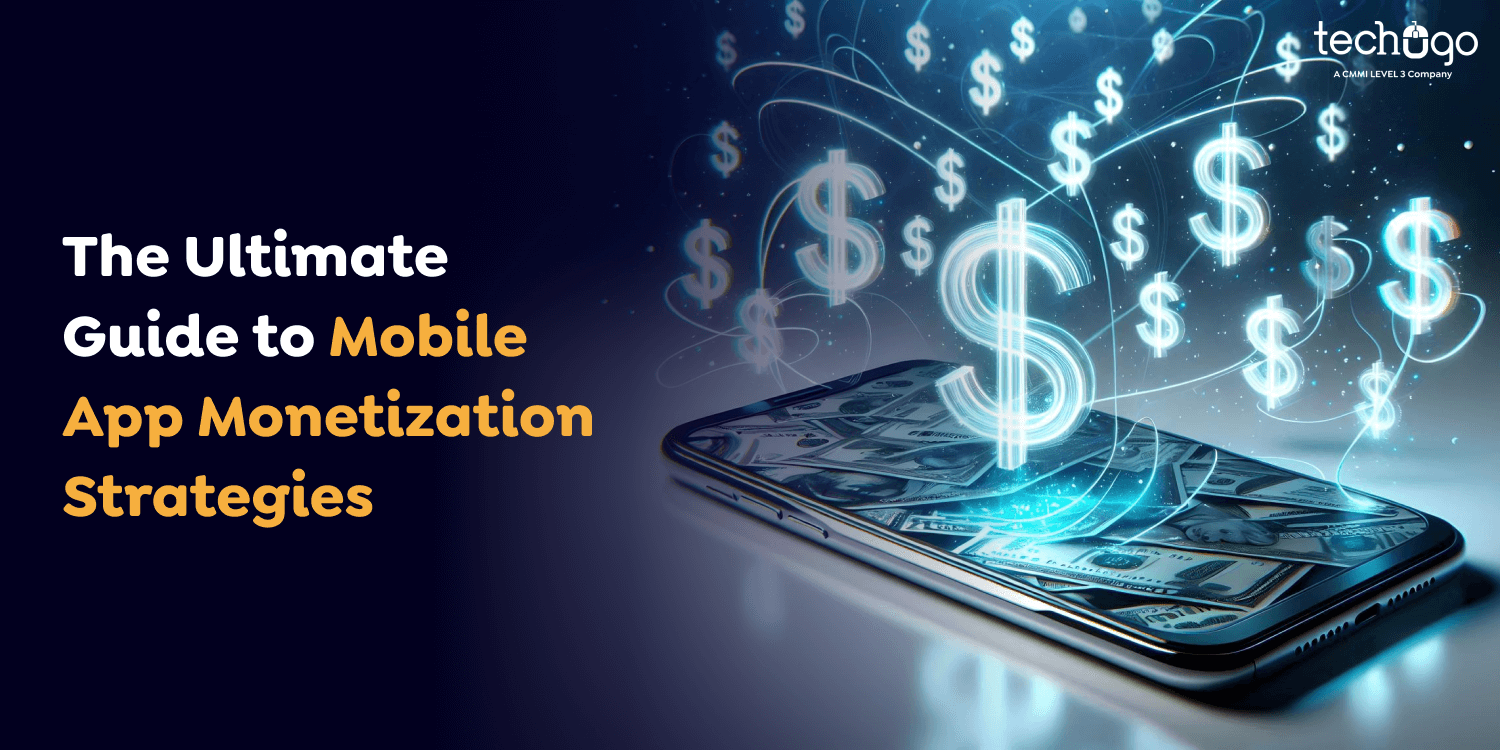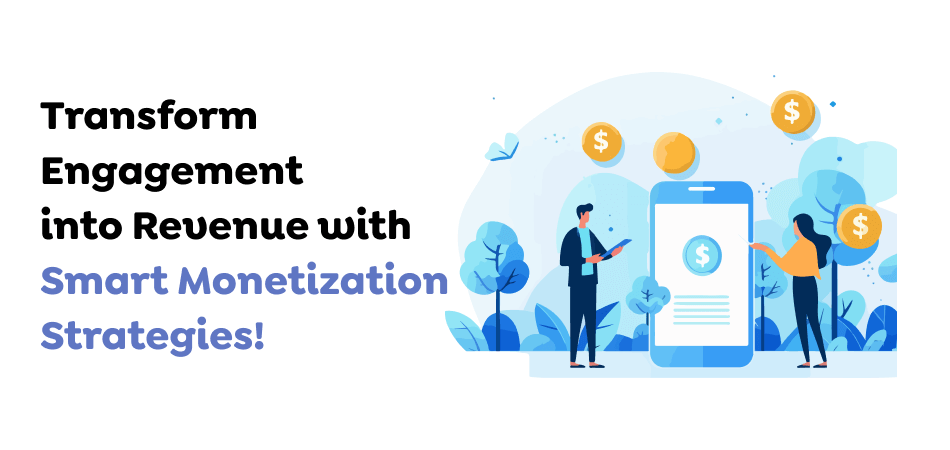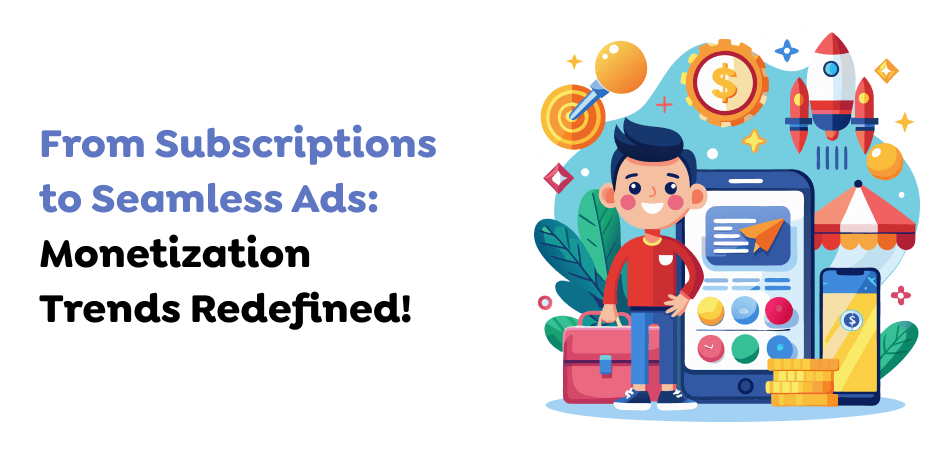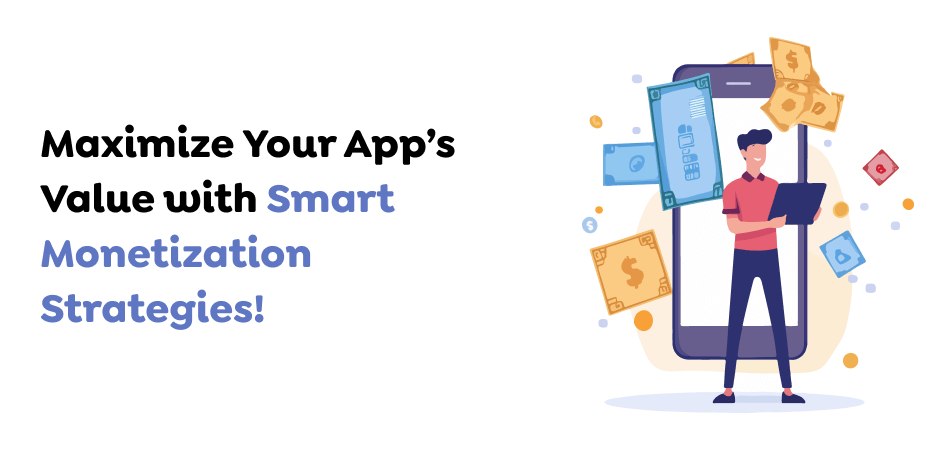31 Dec 2024
Updated on January 30th, 2025
The Ultimate Guide to Mobile App Monetization Strategies
Matthew Connor

The evolution of mobile app monetization strategies in Canada reflects a dynamic and intricate landscape shaped by technological advancements, shifting user expectations, and regulatory influences. Looking ahead, successful monetization strategies will prioritize enhancing user satisfaction and achieving sustainable revenue growth amidst a highly competitive market.
The journey of the Canadian mobile market showcases distinct phases in the evolution of mobile app monetization strategies, each marked by technological innovations and evolving consumer behavior. Early models featured paid apps and ad-supported free apps, gradually giving way to more complex monetization approaches. These include the widely adopted Pay-to-Download model, where users pay a one-time fee to access an app’s full functionality. Over time, these methods have advanced into modern frameworks, often leveraging targeted advertisements and subscription-based services to meet the demands of both users and developers.
Understanding Mobile App Monetization Strategies

Mobile app monetization strategies refer to the various methods and models used by developers to generate revenue from the applications. These are business models that help the application create more reliable revenues based on the app’s characteristics, audience, and usage. The most used strategies are in-app purchases that involve the sale of additional functionalities or content, subscriptions wherein users are charged per use, and Advertising where the app advertises. All the methods suit various kinds of applications and consider users’ tastes and needs, so the income and the main purpose of the app will always be interrelated.
However, it is crucial to state that the model of mobile app monetization strategies can really depend on several factors, including the target clients, trends, and competition in the target market. For instance, freemium apps allow consumers free availability of features in their applications, but they have to pay for more functionality. On the other hand, subscription-based applications, which have become popular in the entertainment and gaming industry, guarantee a constant cash flow in the long run. Furthermore, affiliate marketing and partnerships can bring the second revenue generation channel by offering third-party services in the app. A well-thought-out strategy not only maximizes profits but also maintains user satisfaction, which is crucial for long-term success.
Now, let’s discuss the trends transforming mobile app monetization strategies.
Also Read : How to Build Scalable Apps with Serverless Architecture in Canada
Trends Shaping Mobile App Monetization Strategies

1. The Shift Toward Subscription Models
With evolving consumer preferences, a significant change in the late 2010s was the transition to subscription-based monetization models. These models meet the rising customer expectations of a constant supply of content and services, allowing developers to create constant revenues. This approach proved especially effective for niche content, such as streaming platforms and productivity apps, where recurring fees were justified by the consistent access they provided. This trend points to a general focus on improving customers’ value proposition as well as achieving sustainable revenue growth.
2. Transformations in Advertising Approaches
Technological improvements and developments in digital advertising targeting techniques like programmatic advertising and improvements in data analytics have transformed how mobile application advertising operates. This, in return, has forced developers to incorporate user engagement with new and unobtrusive ad products and services. For example, ad-free services are now being introduced to customers so that they can have continuous access to services and products. For this reason, mobile app monetization strategies should go hand in hand with an emphasis on the satisfaction of the end-users, leading to efficient incorporation of advertisements and low interference with the app environment.
3. Regulatory Influences on Monetization
Regulations, such as emphasizing data privacy, have significantly influenced monetization strategies. In the current economic style, developers are now compelled to be more transparent in the revenues they generate. Data protection laws guarantee that people’s data isn’t abused for dubious purposes while corporations generate revenue from such data. This has shifted developers to compliance and user-friendly practices.
4. Global Influences on Monetization Trends
Global trends in mobile app monetization strategies, such as content-driven applications and innovative advertising strategies, have increasingly entered the Canadian market. International players have demonstrated the effectiveness of culturally tailored advertising campaigns, inspiring Canadian developers to adopt similar approaches. This has increased the call for cross-regional strategies and culturally appealing information significantly within a highly connected world economy.
Moving forward, let’s explore how to monetize an app.
Also Read : The Ultimate Guide to Using AI Recommendation Engines in Travel
How to Monetize Your App: Effective Strategies for Success
 1. In-App Purchases (IAP)
1. In-App Purchases (IAP)
In-app purchases allow you to generate revenue by selling additional features, content, or virtual goods inside your app. This model is especially popular in gaming, entertainment, and lifestyle apps. Here are some types of in-app purchases:
- Consumables: These are items bought and used by users within the app environment, like virtual currency, health boosters in gaming, and App boosts for Social aspects.
- Non-Consumable: These are everlasting items bought by the user only once, such as combined items, feature unlocking, etc.
- Subscriptions: In the same vein as the above, in-app purchases are also a standalone strategy, but they are often applied to the subscription services.
2. Subscription Models
Subscription-based monetization makes application monetization one of the most sustainable sources of income, which will be perfect for applications that deliver value continuously. In entertainment, fitness, and productivity apps, people sign up for a particular monthly, weekly, or daily recurring fee to use valued content or features.
Types of subscription models include:
- Freemium Subscription: Some services are available for free with limited options, content, or functionality, while others require the purchase of upgrades, additional content options, or functionality.
- Pay-Per-Use: Users pay for specific services or content on a one-off basis, like renting movies or paying for a one-time download.
- Tiered Subscription: This provides the user with a number of prices that can be effectively ranked by the amount of usage or access and service necessary, allowing the user to decide according to their budget.
- Free Trial: Provide a limited-time trial for some application features in the hope of converting users after the trial period elapses and compel them to start paying for the application.
Subscription models provide predictability in revenue and encourage long-term user engagement. However, your app must continue offering fresh content or valuable features to retain subscribers over time.
3. Ad-Based Monetization
If your app offers free content, integrating ads is an excellent way to monetize it. There are different forms of ads that you can incorporate into your app:
- Banner Ads: These pop up at the top or bottom of the page and generate predictable and sustained ad revenue with little intrusion.
- Interstitial Ads: Interstitial ads pop up on the full screen when the user switches from one level to another in a game or after completing the viewing of a video.
- Native Ads: These are ads that are part of the app’s content but which don’t interfere with the content being delivered to the user, thus making it less intrusive and more natural.
- Video Ads: In video-based applications or games, it is possible to integrate short video ads in which users can get bonuses in terms of coins or special levels.
In essence, ad-based monetization means that ads must not negatively affect the usage of the application or game. This means that if one puts too many adverts or interrupts the users in the wrong way, they will be chased away.
4. Freemium Model
Freemium refers to the business model in which applications are provided for free, and the advanced tools are available at a fee. It is especially valuable for apps that contain primary values of the app but supplies extra and enhanced value with purchase.
Examples of freemium features include:
- Extra tools or customization options (e.g., more templates in design apps).
- Removing ads or offering an ad-free experience.
- Unlocking exclusive content or functionalities (e.g., premium game levels, exclusive fitness plans).
On the other hand, even though the freemium model attracts many users, not all of them are likely to pay for the premium service. However, due to the large number of users, it becomes easier to transact high value at a lower conversion rate.
5. Affiliate Marketing
This business model lets you earn money by advertising other people’s goods and services in your app. The earnings that the users generate through the sales made by clicking the referral link entitle the link holder to a commission.
Examples include:
- Product Recommendations: If you own an application related to shopping or e-commerce, you can earn money by promoting products and getting a commission for each sale you make.
- Promoting External Services: For a fitness app, you could promote external health supplements or gym memberships and earn a percentage from each sign-up or purchase.
- Collaborative Partnerships: Partnering with other businesses for cross-promotions, where both apps benefit from each other’s audience, increasing revenue potential.
Affiliate marketing is a passive monetization strategy that works best when your app has a substantial user base. It also works particularly well for apps with targeted niches, as you can promote highly relevant products to users.
6. Paid Downloads
Charging users to download your app upfront is one of the oldest forms of app monetization. This model can make money quickly, but it is not very popular at present as almost everybody downloads free apps, and there are millions of apps in the app stores.
In order to achieve success, paid applications must be designed to provide customers with well-defined benefits that are not available from competing applications. For paid apps to succeed, they need to offer clear, unique value that justifies the price. Examples of successful paid apps include games with exclusive content, professional apps for businesses, or apps that provide educational tools. However, the paid model cannot work well when there are a huge number of applications, and most of them are available for free. Some have moved to in-app purchases or freemium to sustain the business.
7. Crowdfunding
Crowdfunding is the practice of sourcing funds from a large number of people who have an inclination to support a certain application before it develops into a full-fledged product. This method is most effective if your app solves a problem or covers an idea no one has implemented before. App developers can attract financial support in exchange for future product access or perks. Crowdfunding is a method that actively involves users in developing an app before it is released to the market, so you will have backing when you have what it takes to develop the app.
8. Partnerships and Sponsorships
Forming strategic partnerships with brands or businesses can open up multiple monetization channels. This could involve:
- Cross-Promotions: Sponsor another app or company, introduce their services to the audience, and promote your own app or company services to your audience as well.
- Brand Sponsorship: Companies may fund your application or any aspect of it, such as a particular event, in the hope of gaining publicity.
- Bundled Services: The idea behind developing a synergy with other apps or companies is that joint offerings can lower the overall price of your app, improving the value for the consumer and opening up new income streams.
Let’s explore the challenges and opportunities in mobile app monetization strategies.
Also Read : How to Develop a Social Media App: From Concept to Monetization Strategies
Challenges and Opportunities in Monetization
As mobile app monetization strategies continue to evolve, developers must navigate a range of challenges. One of the most persistent hurdles is finding the right balance between generating revenue and maintaining a positive user experience. Overemphasizing mobile app monetization strategies can often lead to user dissatisfaction, which can result in a drop in engagement and retention rates. This ongoing challenge requires developers to constantly reassess their strategies to ensure they don’t sacrifice user satisfaction for financial gain.
-
Balancing Revenue and User Experience:
One of the problems that many developers are familiar with is the conflict between the desire to increase revenue and the need to provide an unobtrusive and enjoyable experience for the user. Too much focus on monetization, such as excessive ads or aggressive in-app purchase prompts, can frustrate users and push them away. Finally, the main challenge is to spread the monetization elements throughout the app without overly burdening the user; app planning and daily changes to the app’s course are essential. Once again, developers must pay attention to users’ responses and analytics to determine when a particular monetization method is no longer helpful and changes direction.
-
Continuous Strategy Testing and Optimization:
This means that the balance between monetization and user satisfaction strategies has to be worked through constantly, through constant testing. This requires experimenting with different pricing models, ad formats, and subscription structures. It is important to study how different changes impact user engagement or result in app performance modifications; this entails features such as A/B testing, user feedback, and data analytics. With the above knowledge, developers are also able to optimize the type and manner of monetization of the platforms adopted to remain efficient and accurate without harming the users’ experience.
-
Innovative Approaches to Monetization:
In the competitive Canadian app market, developers are exploring innovative ways to diversify revenue streams and enhance the user experience simultaneously. Strategic collaboration is one of the most promising areas for further investigation. Thus, business or app developers can partner with other companies to provide a range of more appealing services to the final consumer. For example, an app may work with a streaming service to provide clients with a special material or a discount, which creates higher usage of the product by consumers and reveals new ways of making money from it.
-
Leveraging Collaborative Monetization Models:
Collaborative monetization strategies are gaining attraction, especially for apps targeting niche markets. Developers can introduce joint marketing campaigns, affiliate programs, and shared revenue models by joining forces with like-minded businesses or platforms. These partnerships allow apps to expand their reach, attract new users, and create multiple sources of income while avoiding the risks associated with over-reliance on traditional monetization methods like ads or in-app purchases.
Also Read : How Much Does It Cost to Develop a Fitness App Like Strava?
Future Improvements in Mobile App Monetization
As mobile app monetization strategies continue to prioritize user-centric strategies, the next step will be the integration of advanced technologies to further enhance personalized experiences. Artificial intelligence (AI) and machine learning (ML) are expected to play a pivotal role in this shift. By leveraging these technologies, developers can create highly customized user experiences, offering personalized recommendations, tailored pricing models, and dynamic content that resonates with individual users. This level of customization will drive engagement, making users feel more connected to the app and increasing the likelihood of conversion during monetization touchpoints.
Looking ahead, the adoption of these advanced technologies will also enable developers to refine their mobile app monetization strategies continuously. AI and ML can analyze vast amounts of user data in real-time, providing insights that allow for quick adaptations to changing preferences and behaviors. With this data-driven approach, apps will be able to optimize their monetization efforts, ensuring they remain relevant and effective in meeting both user needs and business goals. This evolution will lead to more sustainable and efficient revenue models, ultimately improving the user experience while driving growth for developers in the competitive Canadian market. Moreover, our mobile app development company in Canada can help you create sustainable revenue models for your app!
Get in touch with Techugo today to discover effective mobile app monetization strategies.
Get In touch
We are excited to here from you and let’s start something special Together. Call Us for any inquiry.
Write us
sales@techugo.caJust a call away
About you




